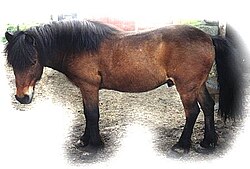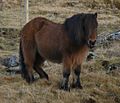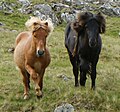Faroe pony
| Faroe pony | |
|---|---|

|
|
| Important data | |
| Origin: | Faroe Islands |
| Main breeding area: | Faroe Islands |
| Distribution: | 73 animals in the Faroe Islands (2016) |
| Stick measure : | 115-125 cm |
| Colors : | Brown, black-brown, fox, various piebalds and other colors |
| Main application area: | Recreational riding |
The Faroe pony ( Faroese : føroysk ross ) is a separate breed of horse that differs from the Icelandic horse and fjord horse , which are now in the majority in the Faroe Islands .
The Faroe pony is slightly smaller than the Icelandic horse, to which it is closely related. As in this breed, there are individuals who have mastered five gaits (walk, trot, tölt, pass, canter). It is an independent breed, as proven by blood tests and most recently a DNA analysis in September 2004.
Origin and previous use
His ancestors were probably together with other pets in the 7th century by the Irish monks and later during the conquest by Vikings brought to the Faroe Islands from the 9th century. It has adapted well to the harsh Faroese nature, is resilient, frugal and tough.
At the turn of the century (from the 19th to the 20th century) there were still many ponies of the original Faroese breed on the islands. In the travel report of the English Maria expedition from 1854 it says about a ride from Hvalvík to Vestmanna :
- “About two hours after we arrived, the farmer came in to let us know that the ponies were ready, which the servants in the meantime had been capturing in the mountains, where they would be left to run and to graze when they did weren't exactly needed. [...] We hiked and rode alternately. The extremely sure-footed ponies climbed up and down places where even their Welsh conspecifics would have been unsettled. "
In the same report from 1854 it says:
- “Two loads of the latter [ponies] go from Suderoe to the Shetland Islands each year . They are strong, hardened little animals, about twelve and a half hands high. The locals only use them for riding and for carrying loads in baskets that are attached to their backs, but never as draft animals. "
Before World War II , many ponies were exported to Great Britain as pack animals for British coal mines , where they were used like the Shetland ponies . While the Faroe pony was being exported, other ponies were imported from Iceland and Norway .
The Faroe pony was bred further and further and its distinctive features gradually disappeared. In the 1960s there were only 4-5 copies left in the Faroe Islands. By 2007, the number of individuals on the Faroe pony had risen to 45. In May 2016 the 73rd animal of this rare horse breed was born.
photos
literature
- Bonnie L. Hendricks: Faeroe Island Horse . In: (dies.): International Encyclopedia of Horse Breeds . University of Oklahoma Press, Norman (et al.) 1995, pp. 182-3
Web links
- Felagið Føroysk Ross , ffr.fo (In Faroese)
- Føroyska Rossið , rossid.com (In Faroese)
- Pony on the Faroe Islands , Stamps.fo (German, stamp issue from 1993, partly basis for this article)
- Faroestamps.fo - travel report from 1854 . faroestamps.fo (in German). Archived from the original on September 20, 2008.
- Føroyski hesturin . teletech.fo (in Faroese). Archived from the original on September 28, 2007.
Individual evidence
- ↑ Nú eru 73 føroysk ross , kvf.fo, 23 May 2016. The short film shows the birth of the foal.




